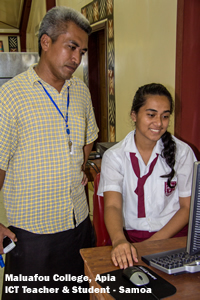Appendix A:
Approach to Curriculum Revision and Materials Development
Introduction
Traditionally, most course designers follow a publishing model wherein they strive for a “polished” final product. The popular and often quoted ADDIE Model (3) is indicative of this approach. “Analyse, Design, Develop, Implement and Evaluate” has been the mantra of a generation of instructional designers. While the model does not exclude the opportunity for reiterative cycles of improvement, the single loop described in the acronym suggests that one round of evaluative reflection should be sufficient for most courses. In many ways, this approach mimics the publishing model that strives to create a polished, authoritative tome, which might be tweaked in subsequent editions but whose first edition can stand alone. Perhaps because many lecturers hope to ultimately publish their research findings and/or their course materials in either journals or academic publications, and their teaching materials as textbooks, the publishing model is easily assumed to be appropriate for course development too.
An alternative approach to the development of courses and their materials, however, might better serve both students and lecturers. The recent creation of a professional development course for teachers in the Caribbean (4) used a very different approach. It brought into play combinations of new course design components and tools that demanded a different mind-set to assemble and deploy the course. The ubiquitous use of electronic materials, along with user-friendly digital technologies and a preference for free and open teaching resources — each of these components characterised by constant flux and evolution —  demanded a quicker and cheaper development cycle than was normally associated with course design and materials development. The optimal “assemblage” of components one month was quickly superseded by new needs and new opportunities a few months later.
demanded a quicker and cheaper development cycle than was normally associated with course design and materials development. The optimal “assemblage” of components one month was quickly superseded by new needs and new opportunities a few months later.
Consequently, the course development model designed for the Caribbean project was closer to what some open source software designers advocate for the development of software: “Release Early, Release Often” (RERO) (5). The thinking is that only once the product is deployed and developers can hear user feedback can it truly be customised to suit user needs, and that more “eyes” make it easier to eliminate bugs or other problems. Regular cycles of testing and revision align the product quickly and cost-effectively with user needs.
With course design, however, there are some other advantages to this approach. Besides responding rapidly to user feedback and fashioning a course aligned with student expectations, this model also enables designers to quickly improve the course as new OER or open courseware become available. The digital nature of the materials allows for quick and cost-effective changes to the content. Course components can be replaced easily without affecting those components that are still desired.
- See the Wikipedia entry on the ADDIE model for a more detailed description: http://en.wikipedia.org/wiki/ADDIE_Model
- This Teacher Professional Development project was a collaboration between the Guyana Ministry of Education, the Commonwealth of Learning and the Commonwealth Secretariat. See a generic version of the course at http://ccti.colfinder.org/sites/default/files/PreService_International
- See the Wikipedia entry on the “Release Early, Release Often” development philosophy: http://en.wikipedia.org/wiki/Release_early,_release_often